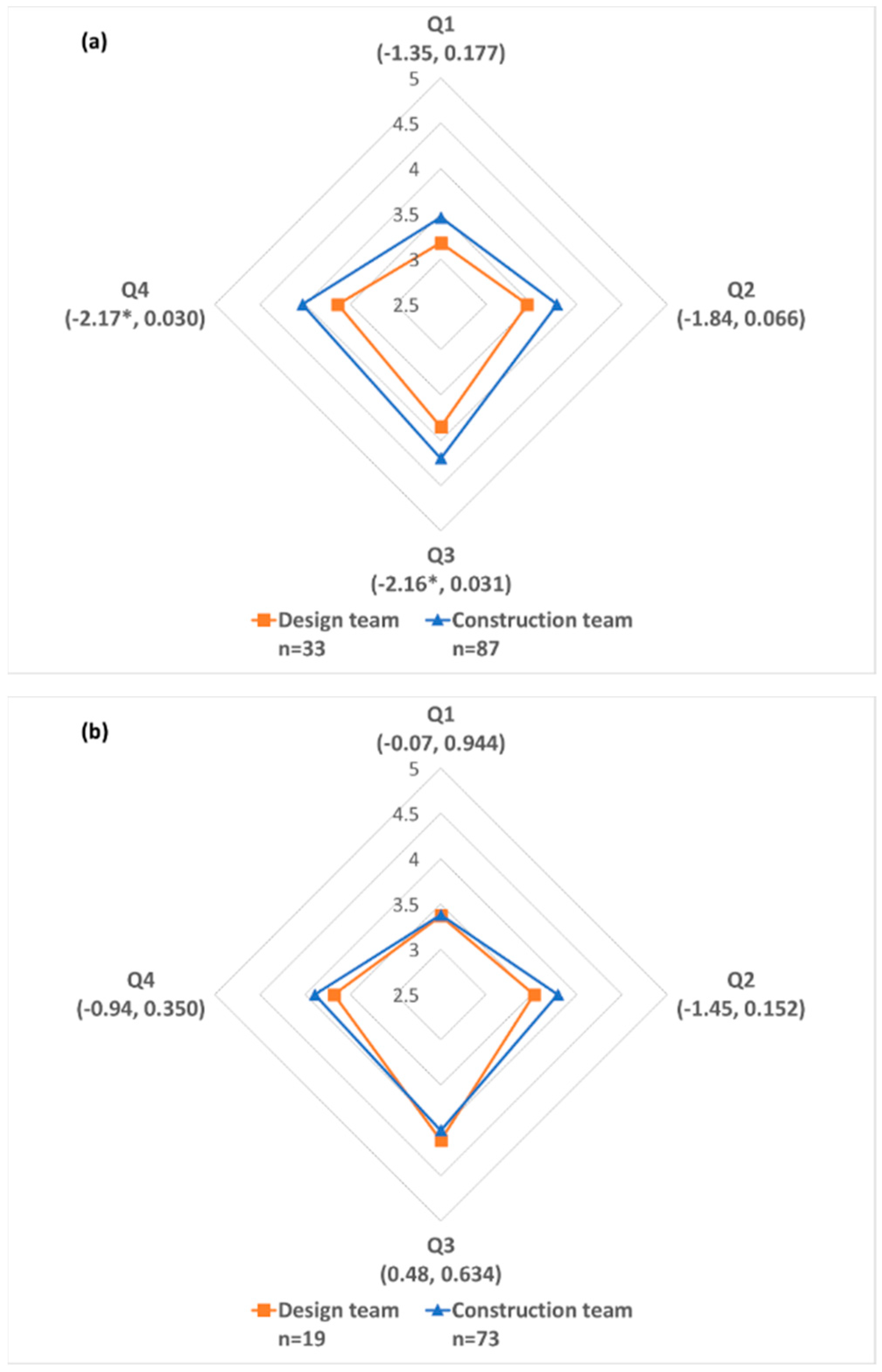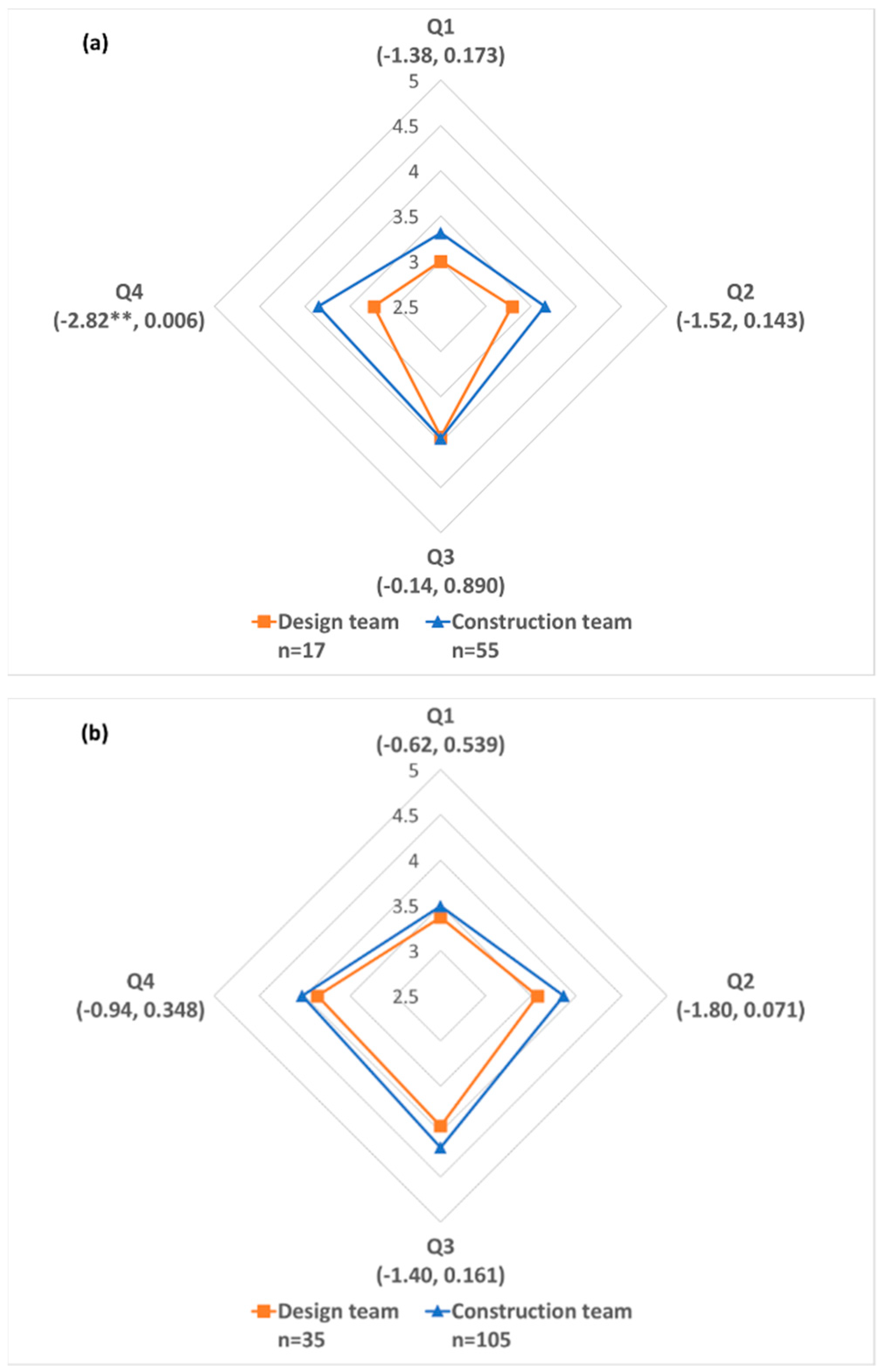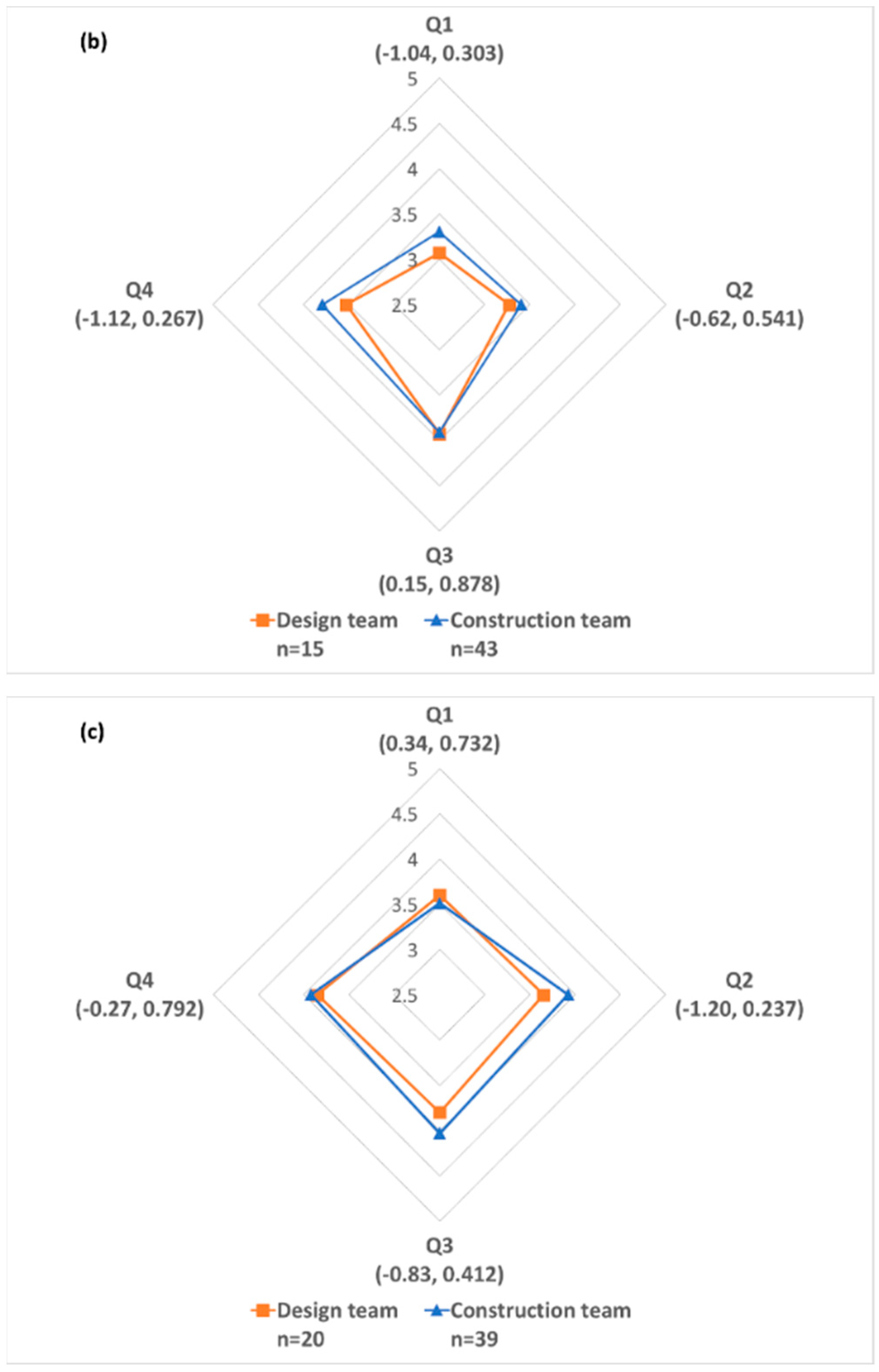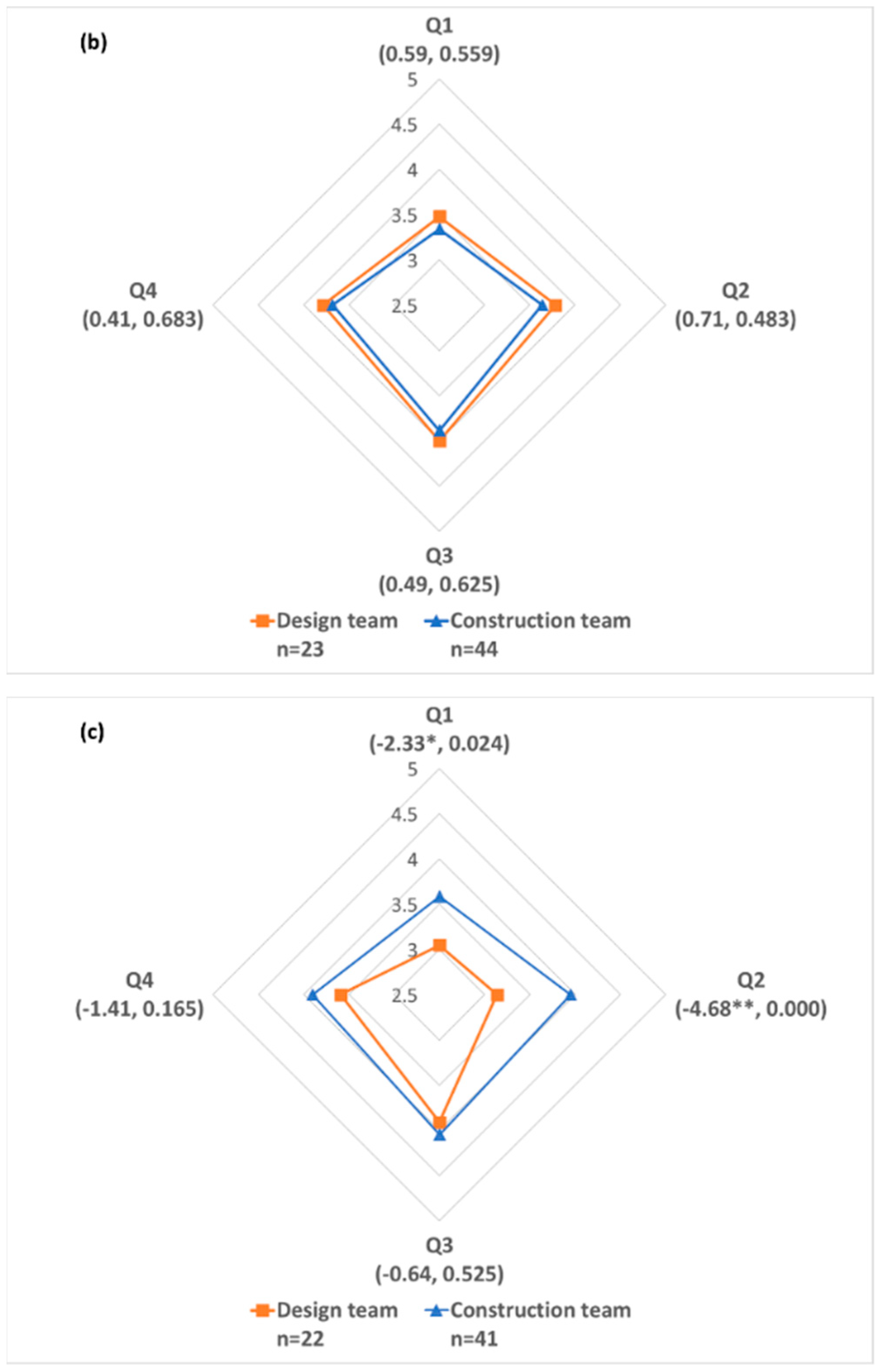Qualitative Analysis of the Occupational Health and Safety Performance of Chinese International Construction Projects
Abstract
:1. Introduction
2. Literature
3. Research Methodology
3.1. Data Collection
3.2. Data Analysis
4. Results
4.1. Comparison within Subgroups by People’s Overseas Experience
4.2. Comparison within Subgroups by Project Size
4.3. Comparison within Subgroups by Project Industry
4.4. Comparison within Subgroups by Project Location
4.5. Comparison within Subgroups by Firm Size
5. Discussion
“There are a lot of emergencies in overseas projects. HSE (occupational health, safety and environment) management serves project implementation and doesn’t belong to productive input. In most of projects, it is kind of passive management.”
5.1. Overseas Experience
5.2. Project Size
“We built ‘Staff Home’ and held sports and recreational activities. Our people can take exercise and play basketball and table tennis. As for large projects, we also organized many learning and training activities.”
5.3. Industry Sector
5.4. Project Location
“In the Middle East, e.g., Saudi Arabia, Kuwait, Dubai, they adopt the most high-end European and American standards and have tough requirements for contractors. In Africa, although with underdeveloped economy, they govern in line with Europe and America and have high requirements for contractors.”
“HSE requirements in the project are very strict. If found there is oil leakage in equipment, it is required to stop the equipment first and then make a four-step report including (1) the reason, (2) how to deal with it, (3) request for the acceptance of dealing measures and results and (4) subsequent preventive measures.”
“Occupational health requirements in Southeast Asia is a little weak”.
“In Southeast Asia, like Cambodia and Laos, the clients, government and supervisors basically didn’t govern the health and safety management issues of contractors.”
“We will hire foreign safety directors, especially in areas with high HSE requirements, to help (1) establish HSE management plan, (2) communicate with clients and (3) make process documents. These safety directors have a high management level equivalent to deputy project manager.”
“HSE management’s priority is to meet the requirements of clients. It depends on the requirements of clients. Generally, it is kind of passive management.”
5.5. Contractor Size
“Management system in our firm is norm, but not efficient. The administration system is too huge in state-owned enterprises. Decision making needs a lot of paper work and takes a long time. This on the hand helps make sure the correct decision and improve risk ability, on the other hand would decrease the efficiency and raise the management cost.”
- Sunindijo claimed that: Large organizations have better safety performance as “they have the resources and leverage to develop and implement robust safety management systems” [30].
- Hasle and Limborg claimed that: Employees from small contractors face higher risks than those from larger ones, as “small enterprises have difficulties in controlling risk” [31].
- Fabiano et al. investigated the relationship between accident frequency and firm size based on industrial data from Italian industry and found that: Accident frequency tends to decrease as firm size increases [32].
- McVittie et al. reviewed records of the Workers’ Compensation Board of Ontario data and found that safety performance is better as firm size increases [33].
- Bena et al. investigated organizational factors for occupational injury in a high-speed railway construction project and found that: Larger firms had a higher injury rate [27].
“When project managers arrived on the site, there was a three-day training about safety and health organized by local environmental engineers. We should pass the training test before job assignment. At the construction stage, (1) before work, we had 10 min safety education and had special training for different types of construction work; (2) during the work, there were supervisors reminding workers to wear masks and gloves; (3) after work, there was a review about the one day’s work performance and the offenders would be criticized by name.”
6. Conclusions
Author Contributions
Funding
Conflicts of Interest
References
- Lu, W.; Ye, K.; Flanagan, R.; Jewell, C. Developing construction professional services in the international market: SWOT analysis of China. J. Manag. Eng. 2013, 29, 302–313. [Google Scholar] [CrossRef]
- Zhao, Z.Y.; Shen, L.Y.; Zuo, J. Performance strategy of Chinese contractors in the international market. J. Constr. Eng. Manag. 2009, 135, 108–118. [Google Scholar] [CrossRef]
- National Bureau of Statistics of China. China Statistical Yearbook; China Statistics Press: Beijing, China, 2016; ISBN 978-7503779176.
- Reina, P.; Tulacz, G.J. The Top 250 International Contractors: Seeking Stable Markets. Available online: https://www.enr.com/articles/40110-top-250-international-contractors-seeking-stable-markets?v=preview (accessed on 21 November 2018).
- Tam, C.M.; Zeng, S.X.; Deng, Z.M. Identifying elements of poor construction safety management in China. Saf. Sci. 2004, 42, 569–586. [Google Scholar] [CrossRef]
- Gurcanli, G.E.; Bilir, S.; Sevim, M. Activity based risk assessment safety cost estimation for residential building construction projects. Saf. Sci. 2015, 80, 1–12. [Google Scholar] [CrossRef]
- Wu, C.L.; Fang, D.P.; Liao, P.C.; Xue, J.W.; Li, Y.; Wang, T. Perception of corporate social responsibility: The case of Chinese international contractors. J. Clean. Prod. 2015, 107, 185–194. [Google Scholar] [CrossRef]
- Zou, P.X.; Zhang, G. Comparative study on the perception of construction safety risks in China Australia. J. Constr. Eng. Manag. 2009, 135, 620–627. [Google Scholar] [CrossRef]
- Rodrigues, F.; Coutinho, A.; Cardoso, C. Correlation of causal factors that influence construction safety performance: A model. Work 2015, 51, 721–730. [Google Scholar] [CrossRef] [PubMed]
- Zhao, D.; McCoy, A.P.; Kleiner, B.M.; Mills, T.H.; Lingard, H. Stakeholder perceptions of risk in construction. Saf. Sci. 2016, 82, 111–119. [Google Scholar] [CrossRef] [PubMed] [Green Version]
- Marin, L.S.; Cifuentes, M.; Roelofs, C. Results of a community-based survey of construction safety climate for Hispanic workers. Int. J. Occup. Environ. 2015, 21, 223–231. [Google Scholar] [CrossRef] [PubMed]
- Lingard, H.; Zhang, P.R.; Blismas, N.; Wakefield, R.; Kleiner, B. Are we on the same page? Exploring construction professionals’ mental models of occupational health safety. Constr. Manag. Econ. 2015, 33, 73–84. [Google Scholar] [CrossRef]
- Gilkey, D.P.; del Puerto, C.L.; Keefe, T.; Bigelow, P.; Herron, R.; Rosecrance, J.; Chen, P. Comparative analysis of safety culture perceptions among homesafe managers workers in residential construction. J. Constr. Eng. Manag. 2012, 138, 1044–1052. [Google Scholar] [CrossRef]
- Chen, Q.; Jin, R. A comparison of subgroup construction workers’ perceptions of a safety program. Saf. Sci. 2015, 74, 15–26. [Google Scholar] [CrossRef]
- Zhao, Z.Y.; Zhao, X.J.; Zuo, J.; Zillante, G. Corporate Social Responsibility for Construction Contractors: A China Study; Research Paper; Emerald Group Publishing Limited: Bingley, UK, 2016. [Google Scholar]
- Casey, T.W.; Riseborough, K.M.; Krauss, A.D. Do you see what I see? Effects of national culture on employees’ safety-related perceptions behavior. Accid. Anal. Prev. 2015, 78, 173–184. [Google Scholar] [CrossRef] [PubMed]
- Ulubeyli, S.; Kazaz, A.; Er, B. Health safety perception of workers in Turkey: A survey of construction sites. Int. J. Occup. Saf. Ergon. 2014, 20, 323–338. [Google Scholar] [CrossRef] [PubMed]
- Geminiani, F.L.; Smallwood, J.J.; Fee, S. A comparative analysis between contractors’ inspectors’ perceptions of the department of labour occupational health safety inspectorate relative to South African construction. Saf. Sci. 2013, 53, 186–192. [Google Scholar] [CrossRef]
- Gyekye, S.A. Workers’ perceptions of workplace safety: An African perspective. Int. J. Occup. Saf. Ergon. 2006, 12, 31–42. [Google Scholar] [CrossRef] [PubMed]
- Louw, L.A.; Schaap, P. Categories of human risk factors which impact on the psychological fitness of construction workers: A review of the evidence. J. Psychol. Afr. 2013, 23, 589–599. [Google Scholar] [CrossRef]
- Zhang, R.P.; Pirzadeh, P.; Lingard, H.; Nevin, S. Safety climate as a relative concept: Exploring variability change in a dynamic construction project environment. Eng. Constr. Archit. Manag. 2018, 25, 298–316. [Google Scholar] [CrossRef]
- Navidi, W.C. Statistics for Engineers Scientists; McGraw-Hill: New York, NY, USA, 2011; ISBN 978-0073401331. [Google Scholar]
- Nordlöf, H.; Wiitavaara, B.; Winblad, U.; Wijk, K.; Westerling, R. Safety culture reasons for risk-taking at a large steel-manufacturing company: Investigating the worker perspective. Saf. Sci. 2015, 73, 126–135. [Google Scholar] [CrossRef]
- Weinstein, M.; Gambatese, J.; Hecker, S. Can design improve construction safety?: Assessing the impact of a collaborative safety-in-design process. J. Constr. Eng. Manag. 2005, 131, 1125–1134. [Google Scholar] [CrossRef]
- Morrow, S.; Hare, B.; Cameron, I. Design engineers’ perception of health safety its impact in the design process. Eng. Constr. Archit. Manag. 2016, 23, 40–59. [Google Scholar] [CrossRef]
- Jannadi, M.O.; Assaf, S. Safety assessment in the built environment of Saudi Arabia. Saf. Sci. 1998, 29, 15–24. [Google Scholar] [CrossRef]
- Bena, A.; Berchialla, P.; Debernardi, M.L.; Pasqualini, O.; Farina, E.; Costa, G. Impact of organization on occupational injury risk: Evidence from high-speed railway construction. Am. J. Ind. Med. 2011, 54, 428–437. [Google Scholar] [CrossRef] [PubMed]
- Ju, C.; Rowlinson, S.; Ning, Y. Contractors’ strategic responses to voluntary OHS programmes: An institutional perspective. Saf. Sci. 2018, 105, 22–31. [Google Scholar] [CrossRef]
- Manu, P.; Mahamadu, A.M.; Van Manh, P.; Thuan The, N.; Ath, C.; Heng, A.Y.T.; Kit, S.C. Health safety management practices of contractors in South East Asia: A multi country study of Cambodia, Vietnam, Malaysia. Saf. Sci. 2018, 107, 188–201. [Google Scholar] [CrossRef]
- Sunindijo, R.Y. Improving safety among small organisations in the construction industry: Key barriers improvement strategies. Procedia Eng. 2015, 125, 109–116. [Google Scholar] [CrossRef]
- Hasle, P.; Limborg, H.J. A review of the literature on preventive occupational health safety activities in small enterprises. Ind. Health 2006, 44, 6–12. [Google Scholar] [CrossRef] [PubMed]
- Fabiano, B.; Currò, F.; Pastorino, R. A study of the relationship between occupational injuries firm size type in the Italian industry. Saf. Sci. 2004, 42, 587–600. [Google Scholar] [CrossRef]
- McVittie, D.; Banikin, H.; Brocklebank, W. The effects of firm size on injury frequency in construction. Saf. Sci. 1997, 27, 19–23. [Google Scholar] [CrossRef]
- Akcay, C.; Aslan, S.; Sayin, B.; Manisali, E. Estimating OHS costs of building construction projects based on mathematical methods. Saf. Sci. 2018, 109, 361–367. [Google Scholar] [CrossRef]
- Karakhan, A.A.; Rajendran, S.; Gambatese, J.; Nnaji, C. Measuring evaluating safety maturity of construction contractors: Multicriteria decision-making approach. J. Constr. Eng. Manag. 2018, 144, 04018054-1. Available online: https://ascelibrary.org/doi/10.1061/%28ASCE%29CO.1943-7862.0001503 (accessed on 21 November 2018). [CrossRef]
- Trinkuniene, E.; Podvezko, V.; Zavadskas, E.K.; Joksiene, I.; Vinogradova, I.; Trinkunas, V. Evaluation of quality assurance in contractor contracts by multi-attribute decision-making methods. Econ. Res. Ekon. Istraz. 2017, 30, 1152–1180. [Google Scholar] [CrossRef] [Green Version]
- Zavadskas, E.K.; Turskis, Z.; Antucheviciene, J. Selecting a contractor by using a novel method for multiple attribute analysis: Weighted aggregated sum product assessment with grey values (WASPAS-G). Stud. Inf. Control 2015, 24, 141–150. [Google Scholar]








| The Questions Applied to Subgroups: M (SD) | n | Q1 | Q2 | Q3 | Q4 | |
|---|---|---|---|---|---|---|
| 1 | Managers 1–5 overseas years | 120 | 3.38 (1.00) | 3.69 (0.82) | 4.10 (0.78) | 3.93 (0.86) |
| Managers > 5 overseas years | 92 | 3.38 (0.82) | 3.74 (0.72) | 4.02 (0.85) | 3.85 (0.85) | |
| 2 | Projects ≤ $100 million US | 72 | 3.24 (0.81) | 3.57 * (0.69) | 3.96 (0.83) | 3.71 * (0.83) |
| Projects > $100 million US | 140 | 3.46 (0.97) | 3.79 * (0.81) | 4.12 (0.80) | 3.99 * (0.86) | |
| 3 | Power projects | 121 | 3.50 * (0.94) | 3.81 * (0.79) | 4.07 (0.80) | 3.91 (0.84) |
| Non-power projects | 91 | 3.22 * (0.88) | 3.58 * (0.75) | 4.05 (0.83) | 3.87 (0.88) | |
| 4 | Southeast Asia | 51 | 3.45 (0.97) | 3.71 b* (0.67) | 4.18 (0.68) | 3.94 (0.86) |
| Islamic Area | 58 | 3.24 (0.76) | 3.36 a*, c** (0.69) | 3.91 (0.73) | 3.72 (0.77) | |
| Sub-Saharan Africa | 59 | 3.54 (0.92) | 3.83 b** (0.83) | 3.95 (0.99) | 3.90 (0.99) | |
| 5 | Firms < $400 million US | 82 | 3.37 (0.91) | 3.77 (0.77) | 4.23 y* (0.71) | 4.11 y**, z* (0.74) |
| Firms $400–800 million US | 67 | 3.39 (0.90) | 3.69 (0.80) | 3.93 x* (0.89) | 3.72 x** (0.95) | |
| Firms > $800 million US | 63 | 3.40 (0.98) | 3.67 (0.76) | 4.00 (0.82) | 3.79 x* (0.85) | |
© 2018 by the authors. Licensee MDPI, Basel, Switzerland. This article is an open access article distributed under the terms and conditions of the Creative Commons Attribution (CC BY) license (http://creativecommons.org/licenses/by/4.0/).
Share and Cite
Lei, Z.; Tang, W.; Duffield, C.F.; Zhang, L.; Hui, F.K.P.; You, R. Qualitative Analysis of the Occupational Health and Safety Performance of Chinese International Construction Projects. Sustainability 2018, 10, 4344. https://doi.org/10.3390/su10124344
Lei Z, Tang W, Duffield CF, Zhang L, Hui FKP, You R. Qualitative Analysis of the Occupational Health and Safety Performance of Chinese International Construction Projects. Sustainability. 2018; 10(12):4344. https://doi.org/10.3390/su10124344
Chicago/Turabian StyleLei, Zhen, Wenzhe Tang, Colin F. Duffield, Lihai Zhang, Felix Kin Peng Hui, and Richun You. 2018. "Qualitative Analysis of the Occupational Health and Safety Performance of Chinese International Construction Projects" Sustainability 10, no. 12: 4344. https://doi.org/10.3390/su10124344





